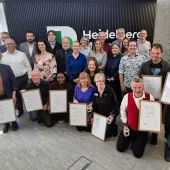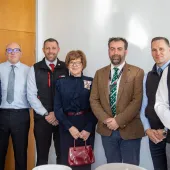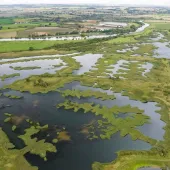RESTORE project ends on a high

Opening of ambitious public access stairway at ENCI quarry brings three-year project to successful conclusion
THE grand opening of an ambitious public access stairway overlooking restoration work some 50m above the ENCI quarry, in Maastricht, the Netherlands, has brought the trans-European RESTORE project to a successful conclusion.
After three years and close collaborative working between seven partners across four countries in north-west Europe (UK, Belgium, Netherlands and Germany), the RESTORE project has now officially come to an end.
Funded by the European Regional Development Fund through the Interreg IVB NWE programme, RESTORE has worked to promote the benefits which can result for people, wildlife and local economies, when mineral sites are restored to a biodiversity-led end-use.
Key achievements and milestones of the project have been:
- The creation of a dedicated website to present the case for biodiversity-led minerals restoration and provide an information hub for stakeholders across north-west Europe
- Engagement with stakeholders from Northern Ireland in the north, to Germany in the south and across a wide cross-section of sectors, through an array of communications channels including: social media; the running of nine best-practice demonstration events and three major conferences; publication of advisory material; articles in industry and specialist press; and media and presentations at international seminars to highlight the great potential which minerals restoration can represent for priority habitat creation in line with European biodiversity targets
- Practical advice for priority habitat creation and management offered on c.2,300ha of land
- Actual on-site priority habitat creation and management on approximately 500ha of land
- A report assessing the ecosystem services benefits (flood alleviation, improved water quality, carbon sequestration, enhancement of health and well-being, green tourism income generation) which can result from biodiversity-led restorations, focusing on 10 sites across the project region as case study examples
- A review of minerals planning policy across the north-west Europe region, with recommendations for the way forward presented in a Manifesto unveiled at the project’s final conference in Brussels in June and attended by MEP and EU representatives and heads of industry, planning and environmental non-governmental organizations
- Collaborative working across north-west European countries, sharing expertise and best practice and exploring innovative ways of working.
Attending the closing event at the ENCI quarry stairway opening, Nigel Symes, head of business advice at the RSPB – the project’s lead partner – commented: ‘The opening of this impressive public access stairway is a fitting event to mark the end of this phase of RESTORE. It highlights how mineral sites which are restored for nature are also good for people in local communities.
‘Very often, sites which are restored with this purpose in mind also present great opportunities for people to re-connect with their local landscape, access green spaces and experience improved health and well-being which being close to nature brings.
‘RESTORE highlights the benefits and services which local communities experience as a result of carefully considered biodiversity-led minerals restoration. Places where nature is able to thrive can, at the same time, provide benefits such as flood-alleviation safeguards, carbon storage and sympathetic green leisure pursuits, all of which directly help the positive regeneration of local economies.’
Mr Symes concluded: ‘Appropriate and sustainable restoration of finished minerals sites represents a mighty opportunity to contribute to the regeneration of Europe’s natural capital. This is a unique opportunity which needs to be seized upon by all interested parties as a means of safeguarding European biodiversity and enhancing the lives of European citizens.’
All outputs of the project are detailed on the RESTORE website: www.restorequarries.eu









